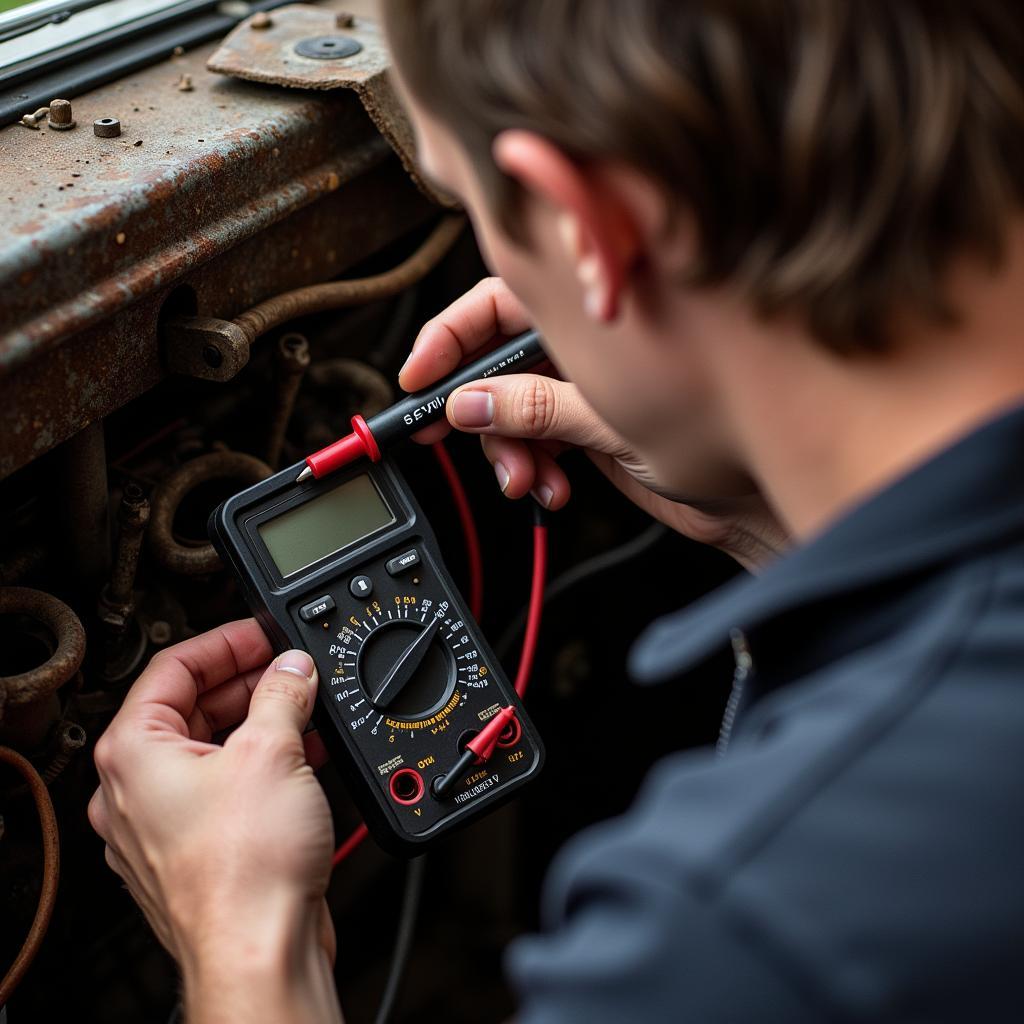Vintage car electrical repairs can be a daunting task for even the most experienced mechanic. Unlike modern vehicles with their computerized systems, classic cars rely on a simpler, yet often more perplexing, electrical setup. This guide delves into the intricacies of vintage car electrical systems, offering valuable insights and practical advice for troubleshooting and repair.
Understanding the Nuances of Vintage Car Electrical Systems
Working on vintage car electrical systems requires a different approach than modern vehicles. These older systems often use 6-volt systems, unique wiring harnesses, and components that are no longer in production. Troubleshooting these systems requires patience, a methodical approach, and a deep understanding of electrical principles. From diagnosing faulty generators to tracing elusive shorts, vintage car electrical repairs present a unique set of challenges.
One common issue is corrosion. Over time, the connections within a vintage car’s electrical system can corrode, leading to poor conductivity and intermittent problems. Another frequent culprit is worn-out wiring. The insulation on older wires can crack and deteriorate, causing shorts and other electrical malfunctions.
 Inspecting a Vintage Car Wiring Harness
Inspecting a Vintage Car Wiring Harness
Essential Tools and Techniques for Vintage Car Electrical Repairs
Having the right tools is crucial for successful vintage car electrical repairs. A multimeter is indispensable for testing voltage, current, and resistance. A wiring diagram specific to the make and model of the car is also essential for navigating the complex web of wires and components. Other useful tools include wire strippers, crimpers, soldering iron, and a good set of electrical connectors.
When troubleshooting, start by checking the battery and its connections. A weak or poorly connected battery can cause a multitude of electrical problems. Next, move on to the ignition system, checking the points, condenser, and coil. Finally, inspect the wiring harness for any signs of damage or corrosion.
Common Problems and Solutions in Vintage Car Electrical Repairs
Several recurring issues plague vintage car electrical systems. These include faulty generators, failing voltage regulators, and problematic starting systems. Understanding these common problems and their solutions can save you time and frustration.
For example, a failing generator can lead to a discharged battery. A faulty voltage regulator can overcharge the battery, causing it to boil over and damage other components. Problems with the starting system can manifest as a slow crank or a complete inability to start the engine.
classic car electrical repairs
Diagnosing and Fixing a Faulty Generator
A faulty generator can be diagnosed by checking its output voltage. If the voltage is too low, the generator may need to be rebuilt or replaced. Sometimes, the problem lies not with the generator itself but with the voltage regulator.
Troubleshooting a Failing Voltage Regulator
A failing voltage regulator can be diagnosed by checking the battery voltage while the engine is running. If the voltage is too high, the regulator is likely the culprit. Replacing the voltage regulator is usually a straightforward process.
Addressing Starting System Issues
Starting system problems can be traced to a variety of sources, including a weak battery, a faulty starter motor, or a bad solenoid. Testing each component systematically is key to identifying the root cause.
classic car electrical repairs
Maintaining Your Vintage Car’s Electrical System
Regular maintenance is crucial for preventing electrical problems in your vintage car. This includes keeping the battery terminals clean and tight, inspecting the wiring harness for damage, and checking the condition of the various electrical components.
“Maintaining a vintage car’s electrical system is like preserving a piece of history,” says renowned classic car expert, Amelia Carter. “Regular checks and preventative measures can significantly extend the lifespan of these intricate systems.”
Conclusion: Keeping the Spark Alive in Your Vintage Car
Vintage car electrical repairs can be challenging but rewarding. By understanding the intricacies of these systems and employing the right tools and techniques, you can keep your classic car running smoothly for years to come. Remember, meticulous maintenance and a proactive approach are key to preventing future electrical issues. With patience and persistence, you can keep the spark alive in your vintage car.
FAQs
- What is the difference between a 6-volt and a 12-volt system?
- How do I test a vintage car battery?
- What are the most common causes of electrical problems in vintage cars?
- Where can I find a wiring diagram for my classic car?
- What are some tips for preventing electrical problems in vintage cars?
- How can I tell if my generator is failing?
- What is the purpose of a voltage regulator?
“Proper diagnosis is half the battle in vintage car electrical repairs,” adds Ms. Carter. “Understanding the symptoms and using the right tools can significantly simplify the repair process.”
Need assistance with your vintage car electrical repairs? Contact us via WhatsApp: +1(641)206-8880, or Email: [email protected]. Our 24/7 customer support team is ready to help.

